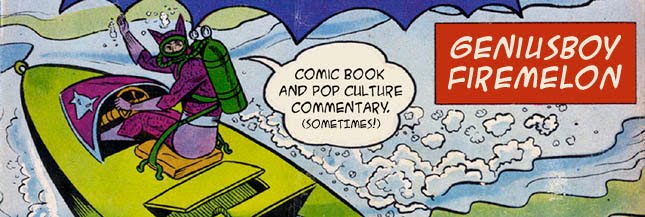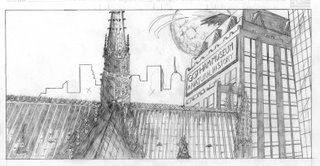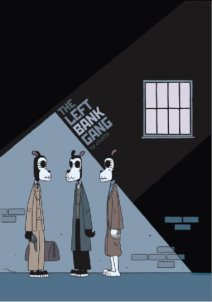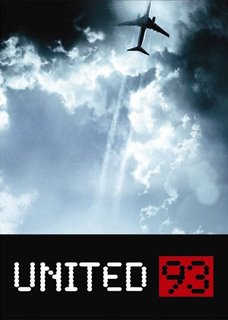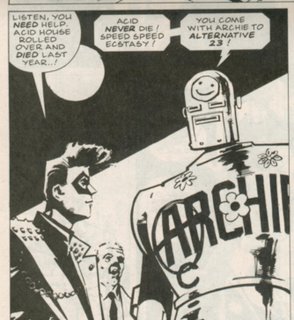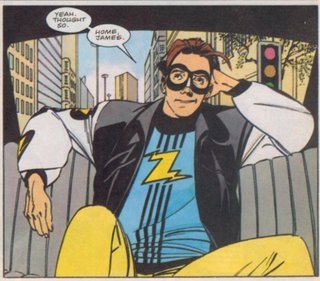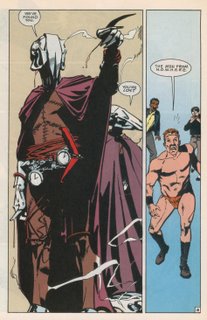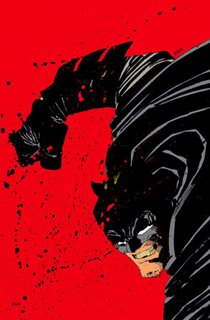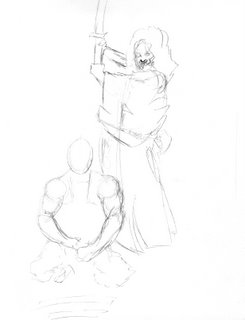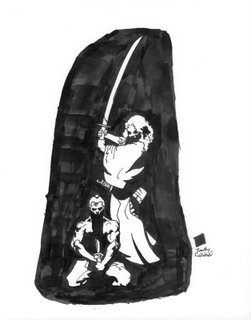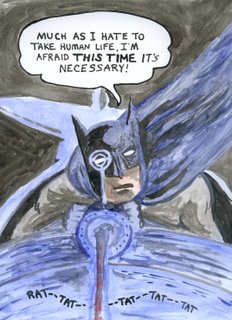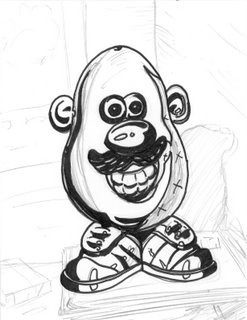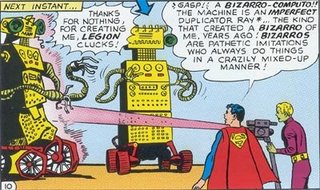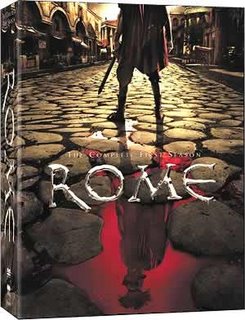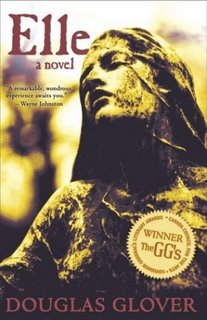I read a ton of comic books, as you've no doubt figured out. I'm going to try to give capsule reviews and grades to everything I pick up each week. (When I get my comics home, I don't just read them in random order. I stack them up so I can read what I'm most excited about first, and then I put the rest of the superhero stuff next and the non-cape stuff last--usually. The list below is the order in which I read the books.) Here goes:
Solo #12, by Brendan McCarthy. This is the last issue of the series unfortunately, because it was consistently one of my favorites. McCarthy is an astounding artist, and although not every page of this comic is a masterpiece (there are a few one-page sequences that are nonsensical, and not in a good way), the bulk of this issue is pure genius. It's worth buying just for his take on The Flash and his brilliant Batman tale. Grade: A-
All-Star Superman #5, by Morrison and Quitely. Wow. I think this is the best comic book published these days. I wish Quitely's art wasn't digitally inked (when he inks himself, the work is perfect--but I realize that he'd be unable to meet the deadline if he did), but the story's amazing. Best Superman comic book in decades. Grade: A+
52: Week Seventeen, by Morrison, Rucka, Waid, Johns etc. One of the better issues of the series. I love the Animal Man, Adam Strange, Starfire subplot, and that gains more prominence in this issue, so I'm all for that. I'm not a Lobo fan, but his appearance in the story is fun and appropriate. Good stuff this time. Grade: A-
Action Comics #842, by Busiek, Nicieza, and Woods. Pete Woods has developed into one of the best superhero artists working today. And the Dave Gibbons covers have been great on this title. Even though I looked forward to reading this issue, I was still surprised with how good it was. It's not transcendently brilliant like Morrison's Superman stuff, but it is an excellent take on the character and this story is filled with several enjoyable sequences. It had stuff I even had to show off to my son because I thought he'd find it cool. And he did. Grade: A
Young Avengers & Runaways #2, by Wells and Caselli. Another solid issue. Wells does a nice job humorously pointing out the similarities between the two teams, and the ending is a shocker. The art is a bit fuzzy for me--I like a bolder black line, but it's shaping up to be a good series overall. Grade: B+
Teen Titans #38, by Johns and Ferreira. This title has been weaker lately than it was pre-Infinite Crisis. I don't mind the new team or the new focus on solving the mystery of what happened during the gap or any of that stuff. It just feels like it's progressing slower than it should. A lot slower than the pace of earlier issues in the series. This book did feature a cool double-page spread showing the rotating cast during the one-year gap--it was fun to see, and it's another thing that my son really liked because it brought several characters from the animated series into the main title. But, other than that, not much going on. Grade: C
X-Men #190, by Carey and Bachalo. I like Carey's superhero work so far, and Bachalo is always great if he's paired with a writer who can keep him focused (which seems to be the case here). I despise Cable, but his appearance is well-written and makes sense in the context. I'm looking forward to seeing where this storyline is headed. Grade: B
The Trials of Shazam! #1, by Winick and Porter. Man, I really dislike Judd Winick's writing. He's not awful, but he's aggressively mediocre. And yet he gets to write such important characters. Captain Marvel deserves a big comeback. This isn't going to be it, I'm afraid. But I'll probably still buy the rest of the series anyway. (It's called an addiction.) Grade: C-
Superman/Batman #29, by Verheiden and Van Scriver. I really don't know what's going on in this storyline. I can't recall the previous issue. Did I miss it? Am I supposed to be confused. It's baffling to me because I feel like I should know what's happening, but there's just a lot of fighting between the superheroes and then Dark Kilowog shows up. Beats me. Grade: C+ (because I'm assuming that everything will be explained OR that I did, in fact, miss an issue)
Ultimate Fantastic Four #33, by Carey and Ferry. Yeah, now this is good. Here's a case where nobody has any idea what's going on. We know some crazy alien super-beings have shown up on Earth, but we don't know their motives and we're not supposed to. Ferry's art is slick (if a bit rushed) and Carey knows how to keep things interesting. Like his work on X-Men, it's good stuff, and it looks to be building toward something. I just hope it pays off. Grade: B+
JLA Classified #26, by Chaykin, Plunkett, and Nguyen. Ugh. This is terrible. The last storyline was really unreadable and the only reason I bought this was because Chaykin wrote this one. But it's going to be a 6-parter and I don't think I'll be able to stick around to find out what happens. The problem is that the story is too heavy-handed in its politics, and it features huge chunks of dull narration, plus it takes the JLA out of costume to send them on a covert mission. I hate to see superheroes out of costume. It doesn't make it more "realistic," it just makes it more bland. Grade: F
Justice #7, by Krueger, Ross, and Braithwaite. I'm going to have to read this all in one sitting when it finally wraps up. Two months between issues is too long to keep the narrative momentum. It's basically just one long sequence from issue 1 on, as far as I can tell, so reading each individual issue with such a gap between really makes me lose interest. I think Ross is a great artist, but Braithwaite is not, so Ross's art suffers by having to follow a weak layout. For now, I'll give it a grade, but I think my grade might be higher when I read the whole collection. Grade (for now): B-
American Virgin #6, by Seagle and Cloonan. I don't really like this series. I want to like it. I like Cloonan's artwork. I like that I have NO IDEA where it's going. I mean, I know the short-term plot, and I assume the main character is going to undergo some kind of change because he's a dick right not, but I'm not sure how long it will take for that change to occur. I think I'd like this series more if I knew it was planned as a finite series. As it stands, it seems too open-ended and I don't trust it. Grade: C-
Ultimate X-Men Annual #2, by Kirkman and Larroca. I have a serious man-crush on Robert Kirkman's writing skills. This guy is the best new superhero writer in a while. I'm sure he'll end up being Marvel's main guy within a year or two (especially after the awesomeness of "Marvel Zombies"). But this issue didn't blow me away. It was shocking though, because it actually had huge implications for three of the characters on the team. Usually Annuals don't cause any lasting impact, but this one surely did. I thought it needed another subplot or two, because it seemed a bit thin though. But it was suprising to see things develop as they did, so bonus points for that! Grade: B+
Black Panther #19, by Hudlin and Eaton. Why do I continue to buy this series? I have no idea. It's totally just a soap opera without much else to recommend it. I liked seeing Dr. Doom and all, but I hated the corny ending with the "kiss and make up" vibe and everything. But I'm going to be forced to get the next issue too because Black Panther and Storm are going to the moon to visit the Inhumans! That should be good! Except I know it won't! Grade: D
Uncle Sam and the Freedom Fighters #2, by Palmiotti, Gray, and Acuna. Beautiful artwork. I don't like computerized effects, but Acuna pulls it off with a unique style that makes everything look wonderfully luminous. The story is a mess, though. Are we supposed to believe that this band of government agents IMMEDIATELY rebels against the military because some old guy in a star-spangled top hat talks to them about democratic ideals? I knew they were going to rebel-I mean, look at the title of the comic--but it should have taken more convincing OR it should have been established that they were reluctantly serving their masters. This issue makes it seem like a radical change of attitude happened from one page to the next. But, the art sure is purty. Grade: B-
The Boys #2, by Ennis and Robertson. This is a bleak and brutal series. And I don't know why Robertson draws the guy to look exactly like Simon Pegg. It's distracting. So far it seems to be like Ennis's "Hitman," but without the humor and with a slower pace. I'll give it a few more issues to establish itself, but things better happen soon! Grade: C
That's a lot of stuff!
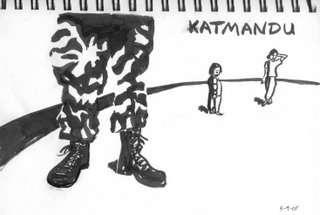 Here's a piece I did last year in my sketchbook based on an image from some magazine--Harper's probably. I was just playing around with geometric shapes and brushwork here, and I like the way it turned out, though when I erased the pencil lines everything smudged and blurred. Which adds a bit of humanity to the image, I guess. I tend to prefer things a little more polished and cold, and that makes a lot of my drawings lifeless, so I've tried to make an effort over recent years to loosen things up, mostly by using brushes to keep me from being to conservative with my line.
Here's a piece I did last year in my sketchbook based on an image from some magazine--Harper's probably. I was just playing around with geometric shapes and brushwork here, and I like the way it turned out, though when I erased the pencil lines everything smudged and blurred. Which adds a bit of humanity to the image, I guess. I tend to prefer things a little more polished and cold, and that makes a lot of my drawings lifeless, so I've tried to make an effort over recent years to loosen things up, mostly by using brushes to keep me from being to conservative with my line.